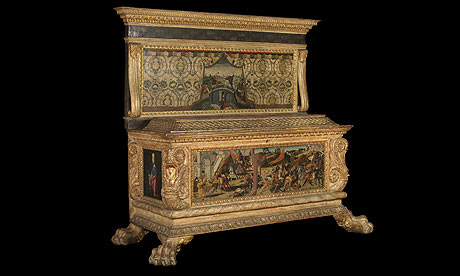For the alternatives unit we started with the renaissance, which was a rebirth not only for architecture, but for furniture, science, art, and many other fields of study. During this period of time we studied how furniture furniture began to take a different shift from what we have studied on the other previous units. As furniture continued to evolve throughout the renaissance period. Two of the most popular types of furniture during this time were the chest and the bed. As evidenced by wealthy individuals would often own hundreds of chests. They were extremely versatile furniture pieces since they could be used to store items inside the home and when traveling. Chests came in all different sizes and shapes, some with legs, and some laying flat on the ground.
We studied how this furniture was made of different precious materials like gold, silver, copper, among others. We also talked about the repetition of patters that in many of this pieces of furniture were used to create balance and harmonious patters.
Beds had many different types of designs and constructions, the most common of which was the rope bed. The rope bed was a fine piece of furniture that consisted of a rectangular wooden frame with ropes. Sometimes individual slept directly on the ropes, while in other instances they were used to support a mattress of some type. The renaissance time is known for its major enhancements to beds and other kinds of furniture. While the most common kinds of furniture during the renaissance period were beds and chests there are many other types that existed during the era. Chairs and benches began to gain more prominence throughout this time. Public furniture, such as the benches, started popping up in more and more locations. Furniture started to have fewer jewels or stones embedded into its borders. Rather banding, paneling, and carving were the primary forms of ornamentation. Banding was simply the addition of thin strips to the borders of furniture. Furniture with paneling was slightly more complex to build. Paneling involved using recessed and raised pieces of wood to enhance the furniture’s appearance. Carving designs into the furniture, is arguably the most artistic of all types of ornamentation. Carvings included simple items such as palmettos in addition to more complex designs depicting everything from trees to animals. When thinking about the renaissance period, the topic of furniture is oftentimes overlooked. As outlined above, the people of this period created beautiful furniture using an artistic approach that was not explored by past generations.
Biagio di Antonio and Jacopo del Sellaio's Morelli Chest illustrating repetition of patterns, balance, contrast and material.
Renaissance revival furniture showing how gold was used in most furniture from this time period.
Then we emerged at the building level, and specifically we talked about the Palazzo medici. This building was the symbol of the economic power of the Medicis who were the virtual lords of Florence, even in the Florentine Republic at the time. The large ground floor windows were designed by Michelangelo. The below elevation shows how the building was split into three different levels, the 1st level was for store purposes, the 2nd for piano nubile, and the 3rd private. It also shows material, repetition of harmonious patterns, and symmetry in terms of what is happening on the left is also happening on the right. Repetition of doors and windows are also a really important feature for the design of this building.


Perspective of the Palazzo Medici courtyard showing Michelangelo's ground floor windows


-Palazzo_Medici_courtyard_Apr_2008_(9).jpg/784px-Palazzo_Medici_courtyard_Apr_2008_(10)-Palazzo_Medici_courtyard_Apr_2008_(9).jpg)
Your example of artifact and its linkeage to the period architectural movement proves you understood the section. You gave an example of a building and linked its characteristics to the period, Good job.
ReplyDelete